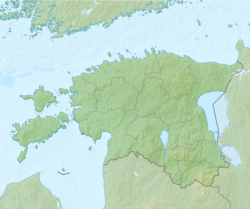Tartu | |
|---|---|
City | |
| Tartu | |
From top: View of Tartu, Tartu old town, Estonian National Museum, University of Tartu, Town Hall Square | |
|
| |
| Nickname: | |
| Motto(s): Heade mõtete linn ("City of good thoughts") | |
| Coordinates: 58°22′48″N 26°43′21″E / 58.38000°N 26.72250°E | |
| Country | Estonia |
| County | Tartu County |
| Municipality | Tartu |
| First settled | 5th century AD |
| First mentioned | c. 1030 |
| City rights | before 1262 |
| Area | |
| • Total | 38.80 km2 (15 sq mi) |
| • Land | 37.9 km2 (14.6 sq mi) |
| • Water | 1.3 km2 (0.5 sq mi) 3.39% |
| Elevation | 57.2 m (188 ft) |
| Highest elevation | 79 m (259 ft) |
| Population (2023)[3] | |
| • Total | 97,435 |
| • Rank | 2nd |
| • Density | 2,500/km2 (6,500/sq mi) |
| GDP | |
| • City | €3.042 billion (2022) |
| • Per capita | €30,569 (2022) |
| Ethnicity | |
| • Estonians | 80.3% |
| • Russians | 13.4% |
| • other | 5.3% |
| Time zone | UTC+02:00 (EET) |
| • Summer (DST) | UTC+03:00 (EEST) |
| Postal code | 50050 to 51111 |
| Vehicle registration | T |
| Website | City of Tartu |
Tartu[a] is the second largest city in Estonia after Tallinn. Tartu has a population of 97,435 (as of 2023).[3] It is 186 kilometres (116 miles) southeast of Tallinn and 245 kilometres (152 miles) northeast of Riga, Latvia. Tartu lies on the Emajõgi river, which connects the two largest lakes in Estonia, Lake Võrtsjärv and Lake Peipus. From the 13th century until the end of the 19th century, Tartu was known in most of the world by variants of its historical name Dorpat.
Tartu, the largest urban centre of southern Estonia, is often considered the "intellectual capital city" of the country,[1][2][5][6][7] especially as it is home to the nation's oldest and most renowned university, the University of Tartu (founded in 1632).[8][9] Tartu also houses the Supreme Court of Estonia, the Ministry of Education and Research, the Estonian National Museum, and the oldest Estonian-language theatre, Vanemuine. It is also the birthplace of the Estonian Song Festivals.
Tartu was designated as the European Capital of Culture in 2024.[2][10][11][12]
- ^ a b "Tartu city". Visit South Estonia. Archived from the original on 24 February 2022. Retrieved 24 February 2022.
- ^ a b c "Tartu – European Capital of Culture 2024". Estonian Convention Bureau (ECB). Archived from the original on 24 February 2022. Retrieved 24 February 2022.
- ^ a b Population of Tartu city as a settlement unit, excluding population of other settlement units of the municipality of Tartu city. Population by sex, age and place of residence after the 2017 administrative reform, 1 January Archived 14 July 2021 at the Wayback Machine. Statistics Estonia.
- ^ "GROSS DOMESTIC PRODUCT BY COUNTY". stat.ee. Archived from the original on 27 October 2022. Retrieved 17 December 2023.
- ^ Tartu – the intellectual centre of Estonia Archived 19 February 2020 at the Wayback Machine estlandia.de
- ^ Jonathan Bousfield The Rough Guide to Estonia, Latvia & Lithuania. Rough Guides UK. Page 126 Archived 10 May 2023 at the Wayback Machine
- ^ Sergey Chernov. Tartu: Estonia's Intellectual and Theater Capital Archived 23 October 2018 at the Wayback Machine The Moscow Times, 24 December 2012
- ^ "Why Tartu?|Visit Tartu". Archived from the original on 13 May 2020. Retrieved 18 June 2020.
- ^ M. Mets & R. Raudsepp: Baltic Piling. CRC Press, 2013. ISBN 9780415643344.
- ^ European Capital of Culture 2024 Archived 6 September 2023 at the Wayback Machine — Ministry of Culture
- ^ Tartu – European Capital of Culture 2024 – Visit Estonia
- ^ Tartu – European Capital of Culture 2024 Archived 19 October 2021 at the Wayback Machine – Tartu.ee
Cite error: There are <ref group=lower-alpha> tags or {{efn}} templates on this page, but the references will not show without a {{reflist|group=lower-alpha}} template or {{notelist}} template (see the help page).









